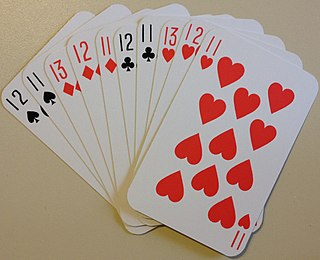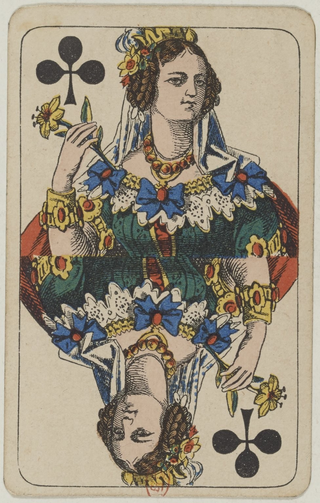
Sheepshead is an American trick-taking card game derived from Bavaria's national card game, Schafkopf, hence it is sometimes called American Schafkopf. Sheepshead is most commonly played by five players, but variants exist to allow for two to eight players. There are also many other variants to the game rules, and many slang terms used with the game.

A trick-taking game is a card or tile-based game in which play of a hand centers on a series of finite rounds or units of play, called tricks, which are each evaluated to determine a winner or taker of that trick. The object of such games then may be closely tied to the number of tricks taken, as in plain-trick games such as contract bridge, whist, and spades, or to the value of the cards contained in taken tricks, as in point-trick games such as pinochle, the tarot family, briscola, and most evasion games like hearts. Trick-and-draw games are trick-taking games in which the players can fill up their hands after each trick. In most variants, players are free to play any card into a trick in the first phase of the game, but must follow suit as soon as the stock is depleted. Trick-avoidance games like reversis or polignac are those in which the aim is to avoid taking some or all tricks.

500 or Five Hundred is a trick-taking game developed in the United States from Euchre. Euchre was extended to a 10 card game with bidding and a Misere contract similar to Russian Preference, producing a cutthroat three-player game like Preference and a four-player game played in partnerships like Whist which is the most popular modern form, although with special packs it can be played by up to six players.

Skat, historically Scat, is a three-player trick-taking card game of the ace–ten family, devised around 1810 in Altenburg in the Duchy of Saxe-Gotha-Altenburg. It is the national game of Germany and, along with Doppelkopf, it is the most popular card game in Germany and Silesia and one of the most popular in the rest of Poland. A variant of 19th-century Skat was once popular in the US. John McLeod considers it one of the best and most interesting card games for three players, and Kelbet described it as "the king of German card games." The German Skat Association assess that it is played by around 25 million Germans – more than play football.

Skitgubbe, and also called Mas, Mjölis, Mjölnarmatte, or Flurst, is a popular Swedish card game that is rated as one of the best for three players. It has two phases: in the first, players accumulate cards; in the second players aim to discard the accumulated hand. The last player to go out is the skitgubbe. Sometimes, the skitgubbe must make a goat noise.
Paskahousu is a popular Finnish card game for two to six players, but three to five are best. The object of the game is to play higher cards than the previously played cards, first to get replacement cards from the stock pile, and, after the stock pile has exhausted, to get rid of one's cards.
High card by suit and low card by suit refer to assigning relative values to playing cards of equal rank based on their suit. When suit ranking is applied, the most common conventions from lowest to highest are:

Rummy is a group of games related by the feature of matching cards of the same rank or sequence and same suit. The basic goal in any form of rummy is to build melds which can be either sets or runs and either be first to go out or to amass more points than the opposition.

Tiến lên is a shedding-type card game originating in southern China and Vietnam. It may be considered Vietnam's national card game, and is also played in the United States, sometimes under the names Viet Cong, VC, Thirteen, or Killer.
3-5-8, also known as sergeant major for its popularity among members of the Royal Air Force, is a trick-taking card game for 3 players, using a standard 52 card deck. 3-5-8 may be played as a gambling game, and there are many variations with names like "8-5-3" and "9-5-2" played throughout the world.
Two-ten-jack is a Japanese trick-taking card game for two players that takes its name from the three highest-scoring cards in the game: the 2, 10 and Jack in three different suits.

Knock-out whist or knockout whist is a member of the whist family known by a variety of names including trumps in Britain, reduction whist, diminishing whist and rat. It is often simply called whist by players who are unfamiliar with the game properly called whist. It is a basic trick-taking game and is a good way to teach the concept of tricks to children.
Svoyi Koziri, Svoi Kozyri or Vsyak svoi kozyri, is a Russian going-out card game for two players which some consider an elaboration of the Czech game Sedma. This game is one of perfect information and hence entirely of foresight and calculation. It differs from almost all other card games, in that the element of luck is eliminated, as, at any one time in the game, a player will know exactly which cards his opponent has.

Botifarra is a point trick-taking card game for four players in fixed partnerships played in Catalonia, in the northeast of Spain, and parts of Aragon, the Balearic Islands and North of the Valencian Country. It is a historical game also played in many parts of Spain, not only in bars and coffee shops. The game is closely related to Manille from which it takes the mechanics, but its rules induce deduction and minimise the effects of luck.

Droggn, sometimes called French Tarock is an extinct card game of the Tarock family for three players that was played in the Stubai valley in Tyrol, Austria until the 1980s. Droggn is originally local dialect for "to play Tarock", but it has become the proper name of this specific Tarock variant. An unusual feature of the game compared with other Tarock games is the use of a 66-card deck and that, until recently, there was no record in the literature of a 66-card game and no current manufacturers of such a deck. The structure of the game strongly indicates that it is descended from the later version of Tarok l'Hombre, a 78-card Tarock game popular in 19th-century Austria and Germany, but with the subsequent addition of two higher bids.

Bauernheinrich is a card game for four players that is played in the region of Anglia in the north German state of Schleswig-Holstein. It is played with a normal Skat pack. The winner is the one to 'go out' first. An unusual feature of this game is that each player has their own trump suit and so can trump others with it; a feature shared with the Czech game, Dudák, and the Russian game, Svoi Kozyri. It is a member of the 'beating game' family.

Kaschlan, Kastellan or Kurrhahn was a simple card game related to the Russian game Durak or German game of Hund. It is for two to five players and may be played with a Skat pack of 32 French- or German-suited playing cards or a standard 52-card French pack.
Voormsi or Vorms is an old, Greenlandic, trick-taking card game of the Brusbart family designed for four players.

Sjavs is a Danish card game of the Schafkopf family that is played in two main variants. In Denmark, it is a 3-player game, played with a shortened pack of 20 cards; in the Faroe Islands, where it is very popular, it is a four-hand, partnership game using a standard piquet pack of 32 cards.

1001 is a point-trick card game of German origin for two players that is similar to sixty-six. It is known in German as Tausendundeins and Tausendeins ("1001") or Kiautschou. The winner is the first to 1001 points, hence the name. Hülsemann describes the game as "one of the most stimulating for two players", one that must be played "fast and freely".













